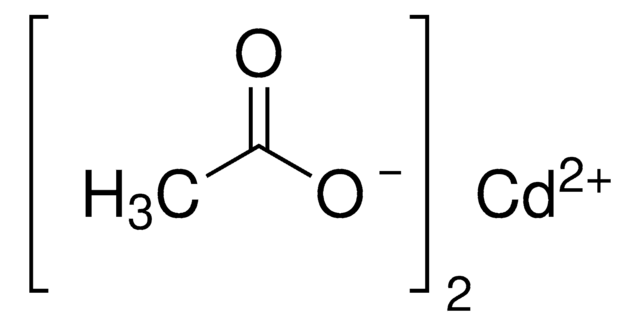202908
Cadmium chloride
99.99% trace metals basis
Synonym(s):
Cadmium dichloride, Dichlorocadmium
About This Item
Recommended Products
vapor density
6.3 (vs air)
Quality Level
vapor pressure
10 mmHg ( 656 °C)
Assay
99.99% trace metals basis
form
solid
reaction suitability
reagent type: catalyst
core: cadmium
impurities
≤150.0 ppm Trace Metal Analysis
mp
568 °C (lit.)
solubility
H2O: soluble 457 g/L at 20 °C (OECD Test Guideline 105)
SMILES string
Cl[Cd]Cl
InChI
1S/Cd.2ClH/h;2*1H/q+2;;/p-2
InChI key
YKYOUMDCQGMQQO-UHFFFAOYSA-L
Looking for similar products? Visit Product Comparison Guide
General description
Application
- As an additive to fabricate perovskite solar cells to improve long-term stability and performance. The incorporation of Cd ions enhances optical absorption and carrier transfer.
- As a precursor to synthesize functionalized cadmium telluride quantum dots for fluorescent immunosensors.
- Aza-Michael reaction of electron-deficient alkene and a wide range of amines.
- The one-pot synthesis of dihydropyrimidones via the Biginelli reaction.
- The synthesis of benimidazoles.
Signal Word
Danger
Hazard Statements
Precautionary Statements
Hazard Classifications
Acute Tox. 2 Inhalation - Acute Tox. 3 Oral - Aquatic Acute 1 - Aquatic Chronic 1 - Carc. 1B - Muta. 1B - Repr. 1B - STOT RE 1
Storage Class Code
6.1A - Combustible acute toxic Cat. 1 and 2 / very toxic hazardous materials
WGK
WGK 3
Personal Protective Equipment
Choose from one of the most recent versions:
Already Own This Product?
Find documentation for the products that you have recently purchased in the Document Library.
Customers Also Viewed
Articles
From Form to Function: Molding Porous Materials in Three Dimensions by Colloidal Crystal Templating
Colloidal quantum dots (CQDs) are semiconducting crystals of only a few nanometers (ca. 2–12 nm) coated with ligand/surfactant molecules to help prevent agglomeration.
Our team of scientists has experience in all areas of research including Life Science, Material Science, Chemical Synthesis, Chromatography, Analytical and many others.
Contact Technical Service










